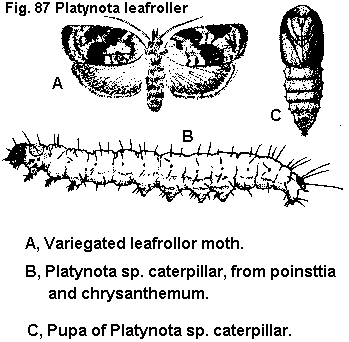 Fig. 87: Platynota
leafrollers. Variegated leafroller, Platynota flavedana
Clemens; omnivorous leafroller, Platynota stultana
Walsingham; tufted apple bud moth, Platynota idaeusalis
(Walker), Tortricidae, LEPIDOPTERA
Fig. 87: Platynota
leafrollers. Variegated leafroller, Platynota flavedana
Clemens; omnivorous leafroller, Platynota stultana
Walsingham; tufted apple bud moth, Platynota idaeusalis
(Walker), Tortricidae, LEPIDOPTERA Return to: MREC Home Page Return to: Key to Caterpillars
CATERPILLARS
Platynota leafrollers
DESCRIPTION
Adult - Female variegated leafroller moths are reddish brown and fairly evenly marked. Males are blackish-brown with contrasting reddish-ochre tips of the wings. The tufted apple bud moth is an ash-gray moth (12 to 25 mm) with blackish and dull-brown markings. There are oblique black lines on the forewings as well as scales that are raised into conspicuous tufts. The hind wings are smoky brown. The palpi are as long as the head and thorax combined.
Larva- Platynota caterpillars are slender, pale, and grow to about 25 mm. Older caterpillars have a dark line along each side of the upper back. The head, thoracic shield, and anal shield are brownish. Platynota caterpillars have a small, but distinct anal comb (see Fig. 70 in Key to caterpillars).
 Fig. 87: Platynota
leafrollers. Variegated leafroller, Platynota flavedana
Clemens; omnivorous leafroller, Platynota stultana
Walsingham; tufted apple bud moth, Platynota idaeusalis
(Walker), Tortricidae, LEPIDOPTERA
Fig. 87: Platynota
leafrollers. Variegated leafroller, Platynota flavedana
Clemens; omnivorous leafroller, Platynota stultana
Walsingham; tufted apple bud moth, Platynota idaeusalis
(Walker), Tortricidae, LEPIDOPTERA
A, Variegated leafroller moth. B, Platynota sp. caterpillar from poinsettia and chrysanthemum. C, Pupa of Platynota sp. caterpillar.
BIOLOGY
Distribution - The variegated leafroller occurs from Maine to Florida and west to Kansas and Texas.
Host Plants - The variegated leafroller has been described as a general feeder. Host plants include apple, clover, maple, rose, sassafras, strawberry, and poinsettia. The tufted apple bud moth has been collected from apple, black walnut, boxelder, pine, and willow. Poinsettia, goldenrod, solanum, and clover are also infested.
Damage - Leaves that are not directly fed upon by the variegated leafroller are ragged and distorted because of the silk tying them together even after the caterpillar has matured.
Life History - There are two main broods of variegated leafroller each year. A large flight occurs in April and May and a smaller flight occurs in August and September. Moths have been collected from April to October. Larvae tie the leaves of poinsettia together with silk and feed within. Tufted apple bud moths overwinter as diapausing caterpillars in the leaf litter. In spring in response to longer days and warmer temperatures, the overwintering caterpillars molt into pupae and 6 to 28 days later a new generation of tufted apple bud moths emerges to mate and lay eggs. Tufted apple bud moth moths have been collected from June to August in New York and April to October in North Carolina. Peak flights occur in April through May and August through October. The developmental rate from egg to adult moth varies greatly with temperature. Complete development takes 25 days at 32.2°C and 140 days at 10.6°C, but the greatest survival of the caterpillars occurred at 26.7°C (35 days from egg to moth). The tufted apple bud moth larvae tie leaves together with silk and reside in the enclosure formed. The worms cut leaves and drag them into the nest. When the leaf has withered sufficiently, the caterpillar then feeds on it.
CONTROL
Larvae of a predaceous mite (Callidosoma metzi Sharma, Drooz and Treat) parasitize the larvae and moths of the tufted apple bud moth from late May through July. Up to 13 larval mites have been found on one moth. Callidosoma metzi deutonymphs and adults feed on caterpillar eggs. This species has potential for biological control. Fenoxycarb applied for tufted apple bud moth control had good residual activity and little effect on beneficial organisms except the ladybird beetle, Stethorus punctum (LeConte). Timing of pesticide applications is critical as these caterpillars become much more difficult to control once the larvae have begun constructing their nests of tied and rolled leaves.
Adults of Platynota leaftiers are large enough to be excluded by ordinary window screening. Commercial flower growers should consider screening as a first pest management practice. For chemical control recommendations, see the current Cooperative Extension publications on ornamental plant pest management.
Reference to University of Florida/IFAS Pest Control Guides